Sustainable Pavement Management System in Urban Areas Considering the Vehicle Operating Costs
Abstract
:1. Introduction
2. Materials and Methods
- (1)
- The method shows the need to create a network pavement inventory, which, in most cases, is non-existent. A Geographical Information System (GIS) is a useful tool to create the network inventory. The network’s elements are divided into sub-units (branches and sections) with homogeneous properties (type of pavement, date of construction, materials, etc.).
- (2)
- First, the pavement distress catalogue adopted in the ASTM 6433 could be used, but in future phases a specific list of distresses and different levels of severity should be defined.
- (3)
- The inventory is updated (network GIS insert data) and completed through pavement visual surveys and traffic counts. This step is vital for determining the current state of the network and to include the effect of traffic in the decision making process (VOC).
- (4)
- The pavement condition evaluation is assessed by the PCI value.
- (5)
- The Vehicle Operating Costs (VOC) is estimated for all the network sections. A written regression between PCI and IRI is used as the relation between IRI and VOC.
- (6)
- The pavement deterioration models are adopted to predict the pavement condition during pavement life.
- (7)
- The maintenance and repair treatment unit costs are defined to estimate the total costs of every considered strategy (LCCA) together in comparison to user costs (VOC).
- (8)
- A comparison among the different strategies is proposed to establish priority in the network sections and to perform the correct choice of M, R&R strategy.
3. Results
3.1. The Urban Road Network of Valentano, Viterbo (Italy)
- Network 1 is the main network of the town. It is 5.47 km long and its function is to connect the provincial road network that connects Valentano with a neighboring town. The type of pavement in this network is flexible.
- Network 2 is the internal traffic distribution network. Most of the pavement type of this network is paved by cobblestone. It is 3.52 km long. In some areas, the level of traffic is high.
- Network 3 has the function to guarantee the access to the residential areas and there are some pedestrian areas as well. It is the longest network in town with a length of 12 km. The level of traffic is low and there is different type of pavement: flexible, rigid and cobblestone.
3.2. Visual Survey: Distress Identification—The PCI Method
3.3. Repair and Maintenance Planning
- Strategy 1. Do Nothing. Aims to show how the network pavement condition evolves by time if no treatment is performed. It is used in this study to compare the differences with the other strategies.
- Strategy 2. Run to failure maintenance. Run to failure maintenance (sometimes known as reactive maintenance) means doing zero prevention or planned maintenance; only repair treatments in the most critical distress areas during the time. Strategy 2 simulates the current maintenance policy of the municipality which consists in making minor treatments (Table 1) when the failure of the pavement has occurred. These repair treatments are performed when some quantities of distress are detected above certain values without any planning. The repair and maintenance works are distributed in the five years of the analysis period, and its influence and cost-effectiveness were analyzed (Table 2). The results of this analysis suggest that a reactive maintenance policy would not be cost-effective if the overall pavement network condition is below the PCI critical threshold.
- Strategy 3. Corrective Maintenance (single investment in the first year). Strategy 3 proposes making major treatments in the first year of the period of analysis with a single investment of 100,000 € to improve the overall PCI of the network into satisfactory condition, from PCI 54 to 74. This strategy includes some major treatments in the 15 most critical sections of the network that are in very poor and serious condition with the highest level of traffic. All the available funds are invested for reconstruction and rehabilitation treatments to bring each of these sections into a satisfactory condition in the first year of the period of study. There is no available budget for minor repairs and maintenance treatments (preventive maintenance) to maintain the overall pavement condition the next four years. Therefore, the average PCI of the network falls to 40 at the end of the five-year period.
- Strategy 4. Corrective Maintenance (investments equally distributed in the period of study). Following the same approach of the previous strategy, Strategy 4 proposes making major treatments in sections with very poor and serious condition but, in this case, the investment is equally distributed in the five years. The repair and maintenance treatments are performed in the most deteriorated sections similarly with Strategy 3, so the sections are the same for both strategies. In this strategy, 20,000 €/year for major treatment is allocated and the overall PCI deterioration rate has a slight decrease from 59 PCI value after the first year to 40 value at the fifth year. The critical state of the network influenced this type of policy (corrective maintenance) to involve immediate action to avoid imminent failures and preserve the condition and service level of the critical pavement sections. The funds were made equally distributed in the period of study because it is difficult for the municipality to address the entire budget in the first year.
- Strategy 5. Corrective maintenance (treatments on low traffic sections). Strategy 5 proposes making major treatments in some sections of the network concentrating the M, R&R works in the first, second and third year of the period of study. These sections are different from those chosen for Strategy 3 and Strategy 4. The objective of Strategy 5 is evaluating the effect of the performance of the M, R&R treatments in those sections with different levels of traffic (traffic level lower than those of the selected sections of the other strategies) in order to compare the results with the aforementioned. The PCI trend (Figure 6) over time of Strategy 5 is similar to that of Strategy 4, so the treatments carried out in these sections are able to maintain the overall pavement condition of the network with an overall PCI value of 40 at the fifth year.
3.4. Life-Cycle Cost Analysis—Vehicle Operating Costs Estimation
4. Discussion
- The analysis carried out is influenced by the agency’s initial target budget to maintain pavements because the proposed method is based on the distribution of the available resources; a change in the initial economic conditions will change the management analysis.
- The lack of planned M, R&R treatments and minor treatments without established priorities to allocate funds (Strategy 2) is equivalent to doing nothing (Strategy 1).
- This case study shows that the budget allocated by the administration is not enough to keep the global network pavement above the critical PCI’s threshold, and it would be necessary to study strategies involved in only a few sections and prioritize actions to achieve the maximum improvement of the global network within the constraints of actual budget (€100,000 every five years).
- If the initial status of the network is very poor or serious, it will be very difficult to achieve an acceptable level of PCI of the global network. It would be advisable to invest in the most critical sections of the network (corrective maintenance) to raise the average PCI to a fair level and then invest in preventive maintenance to maintain the achieved network status (see Strategy 3).
- Although the PCI trend is similar to Strategy 4 and Strategy 5 as shown in Figure 6, Strategy 5 does not reduce the VOC in the same way that Strategy 4 does (Figure 9) because Strategy 4 maintenance policy could maintain the overall conditions in the network sections with higher traffic levels and in worse conditions and, therefore, significantly reduce the indirect costs estimated by the VOC.
- Evidence has been shown that VOC is a valuable tool to include the influence of the level of traffic in the proposed PMS. Indeed, if the repair and maintenance works has been carried out in the sections with higher level of traffic, the indirect costs would be reduced considerably.
5. Conclusions
Acknowledgments
Author Contributions
Conflicts of Interest
References
- Han, D.; Kobayashi, K. Criteria for the development and improvement of PMS models. KSCE J. Civ. Eng. 2013, 17, 1302–1316. [Google Scholar] [CrossRef]
- Shahin, M.Y. Pavement Management for Airports, Roads, and Parking Lots, 2nd ed.; Springer: New York, NY, USA, 2005. [Google Scholar]
- Tavakoli, A.; Lapin, M.; Figueroa, J. PMSC: Pavement Management System for Small Communities. J. Transp. Eng. 1992, 118, 270–280. [Google Scholar] [CrossRef]
- Cantisani, G.; Di Mascio, P.; Moretti, L. Management of road tunnels: Construction, maintenance and lighting costs. Tunn. Undergr. Sp. Tech. 2016, 51, 84–89. [Google Scholar]
- Moretti, L.; Cantisani, G.; Di Mascio, P.; Caro, S. Technical and economic evaluation of lighting and pavement in Italian road tunnels. Tunn. Undergr. Space Technol. 2017, 65, 42–52. [Google Scholar] [CrossRef]
- Moretti, L. Technical and economic sustainability of concrete pavements. MAS 2014, 8, 1–9. [Google Scholar] [CrossRef]
- D’Andrea, A.; Moretti, L.; Di Mascio, P. Environmental impact assessment of road asphalt pavements. MAS 2013, 3, 203–214. [Google Scholar]
- Moretti, L.; Mandrone, V.; D’Andrea, A.; Caro, S. Comparative “from Cradle to Gate” Life Cycle Assessments of Hot Mix Asphalt (HMA) Materials. Sustainability 2017, 9, 400. [Google Scholar] [CrossRef]
- Bonin, G.; Folino, N.; Loprencipe, G.; Oliverio Rossi, G.; Polizzotti, S.; Teltayev, B. Development of a Road Asset Management System in Kazakhstan. In Proceedings of the TIS 2017 International Congress on Transport Infrastructure and Systems, Rome, Italy, 10–12 April 2017; CRC Press/Balkema: Leiden, The Netherlands, 2017; Available online: https://www.crcpress.com/Transport-Infrastructure-and-Systems-Proceedings-of-the-AIIT-International/DellAcqua-Wegman/p/book/9781138030091 (accessed on 19 March 2017).
- Loprencipe, G.; Cantisani, G.; Di Mascio, P. Global assessment method of road distresses. In Proceedings of the 4th International Symposium on Life-Cycle Civil Engineering, IALCCE 2014, Tokyo, Japan, 16 November 2014; CRC Press/Balkema: Leiden, The Netherlands, 2015; pp. 1113–1120. Available online: https://www.crcpress.com/Life-Cycle-of-Structural-Systems-Design-Assessment-Maintenance-and-Management/Furuta-Frangopol-Akiyama/p/book/9781138001206 (accessed on 19 March 2017). [Google Scholar]
- Petschacher, M.; Gragger, K. Asset Management by Means of BAUT. In Proceedings of the 2nd European Pavement and Asset Management Conference, Berlin, Germany, 21–23 March 2004.
- Mannisto, V.; Inkala, M. Road Asset Management Research Program in Finland. Available online: http://alk.tiehallinto.fi/voh/Julkaisut_kon_sem/kon_sem_road_asset_management_reasearch_program_in_finland.pdf (accessed on 30 July 2016).
- Ruotoistenmäki, A.; Seppälä, T. Road condition rating based on factor analysis of road condition measurements. Transp. Policy 2007, 8, 1–9. [Google Scholar] [CrossRef]
- Corazza, M.V.; Di Mascio, P.; Moretti, L. Managing sidewalk pavement maintenance: A case study to increase pedestrian safety. JTTE 2016, 3, 203–214. [Google Scholar] [CrossRef]
- Cottrell, W.; Bryan, S.; Chilukuri, B.; Kalyani, V.; Stevanovic, A.; Wu, J. Transportation Infrastructure Maintenance Management: Case Study of a Small Urban City. J. Infrastruct. Syst. 2009, 15, 120–132. [Google Scholar] [CrossRef]
- Chamorro, A.; Tighe, S.; Li, N.; Kazmierowski, T. Development of Distress Guidelines and Condition Rating to Improve Network Management in Ontario, Canada. Transp. Res. Rec. 2009, 2093, 128–135. [Google Scholar] [CrossRef]
- Chamorro, A.; Tighe, S.; Li, N.; Kazmierowski, T. Validation and Implementation of Ontario, Canada, Network-Level Distress Guidelines and Condition Rating. Transp. Res. Rec. 2010, 2153, 49–57. [Google Scholar] [CrossRef]
- Osorio, A.; Chamorro, A.; Tighe, S.; Videla, C. Calibration and validation of condition indicator for managing urban pavement networks. Transp. Res. Rec. 2014, 2455, 28–36. [Google Scholar] [CrossRef]
- Shah, Y.; Jain, S.; Parida, M. Evaluation of prioritization methods for effective pavement maintenance of urban roads. Int. J. Pavement Eng. 2012, 15, 238–250. [Google Scholar] [CrossRef]
- Rens, K.; Gragger, K. Rating City and County of Denver Urban Pavement Constructability Using a Profiler. Pract. Period. Struct. Des. Constr. 2010, 15, 44–49. [Google Scholar] [CrossRef]
- Arhin, S.A.; Williams, L.N.; Ribbiso, A.; Anderson, M.F. Predicting Pavement Condition Index using International Roughness Index in a Dense Urban Area. J. Civ. Eng. Res. 2015, 5, 10–17. [Google Scholar]
- Cantisani, G.; Loprencipe, G. Road Roughness and Whole Body Vibration: Evaluation Tools and Comfort Limits. J. Transp. Eng. 2010, 136, 818–826. [Google Scholar] [CrossRef]
- Cantisani, G.; Fascinelli, G.; Loprencipe, G. Urban road noise: The contribution of pavement discontinuities. In ICSDEC 2012: Developing the Frontier of Sustainable Design, Engineering, and Construction, Proceedings of the 2012 International Conference on Sustainable Design and Construction, Fort Worth, TX, USA, 7–9 November 2012; American Society of Civil Engineers: Reston, VA, USA, 2012; pp. 327–334. Available online: http://dx.doi.org/10.1061/9780784412688 (accessed on 18 March 2017).
- Loprencipe, G.; Zoccali, P. Use of generated artificial road profiles in road roughness evaluation. J. Mod. Transp. 2017. [Google Scholar] [CrossRef]
- Loprencipe, G.; Pantuso, A. A Specified Procedure for Distress Identification and Assessment for Urban Road Surfaces based on PCI. Coatings 2017. in review. [Google Scholar]
- Bennett, C.R.; Greenwood, I.D. Volume 7: Modeling Road User and Environmental Effects in HDM-4, Version 3.0; International Study of Highway Development and Management Tools (ISOHDM); La Défense Cédex World Road Association (PIARC), Paris/The World Bank: Washington, DC, USA, 2001; Available online: www.lpcb.org (accessed on 5 May 2016).
- Archondo-Callao, R. Applying the HDM-4 Model to Strategic Planning of Road Works; The World Bank: Washington, DC, USA, 2008. [Google Scholar]
- Bennett, C.; Paterson, W. Volume 5: HDM-4 Calibration Reference Manual, International Study of Highway Development and Management Tools (ISOHDM); La Défense Cédex World Road Association (PIARC), Paris/The World Bank: Washington, DC, USA, 2003; Available online: www.lpcb.org (accessed on 5 May 2016).
- De Weille, J. Quantification of Road User Savings; World Bank Staff Occasional Paper No. 2; The World Bank: Washington, DC, USA, 1966. [Google Scholar]
- Becker, M.A. Selection of Optimal Investment Strategies for Low Volume Roads. Ph.D. Thesis, Massachusetts Institute of Technology, Cambridge, MA, USA, 1972. [Google Scholar]
- Zaniewski, J.P.; Butler, B.C.; Cunningham, G.; Elkins, G.E.; Paggi, M.S.; Machemehl, R. Vehicle Operating Costs, Fuel Consumption, and Pavement Type and Condition Factors; Report FHWA/PL/82/001; U.S. Department of Commerce National Technical Information Service: Springfield, VA, USA, 1982. Available online: https://ntl.bts.gov/lib/42000/42200/42239/FHWA-PL-82-001.pdf (accessed on 18 March 2017).
- Chatti, K.; Zaabar, I. Estimating the Effects of Pavement Condition on Vehicle Operating Costs. Available online: https://www.nap.edu/read/22808/chapter/1 (accessed on 19 May 2016).
- American Society of Testing and Materials (ASTM). D6433-16, Standard Practice for Roads and Parking Lots Pavement Condition Index Surveys. Available online: www.astm.org (accessed on 19 May 2016).
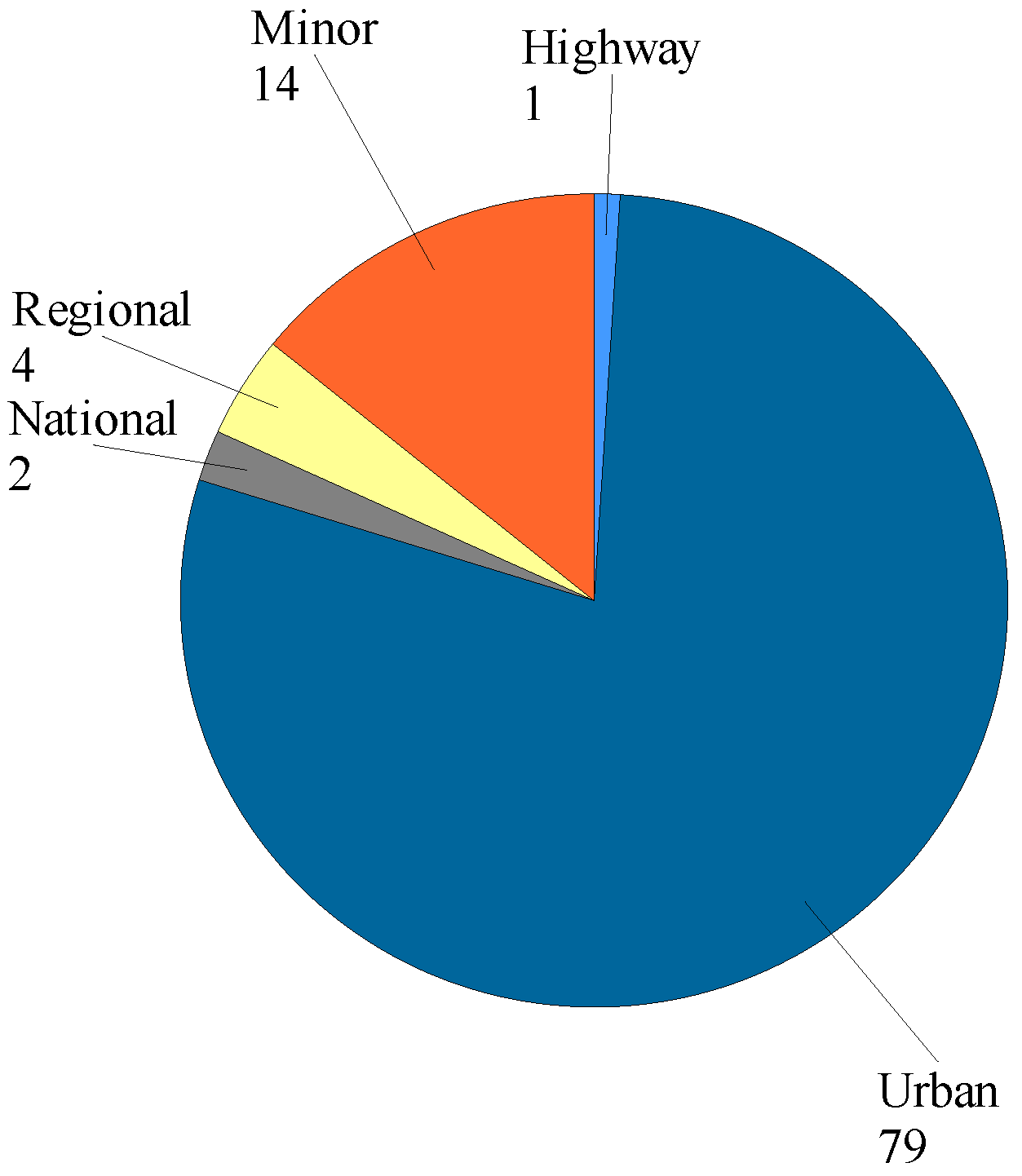

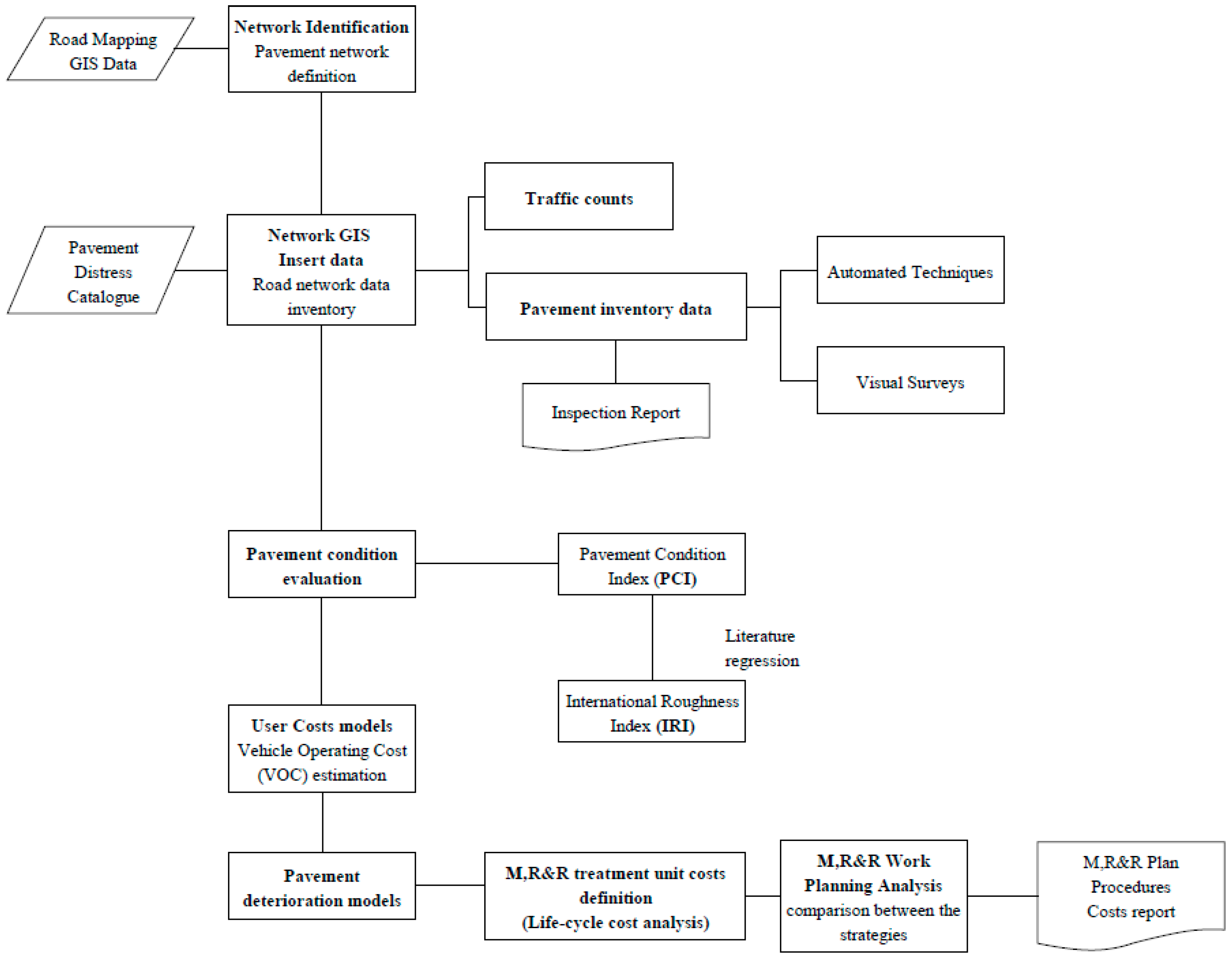
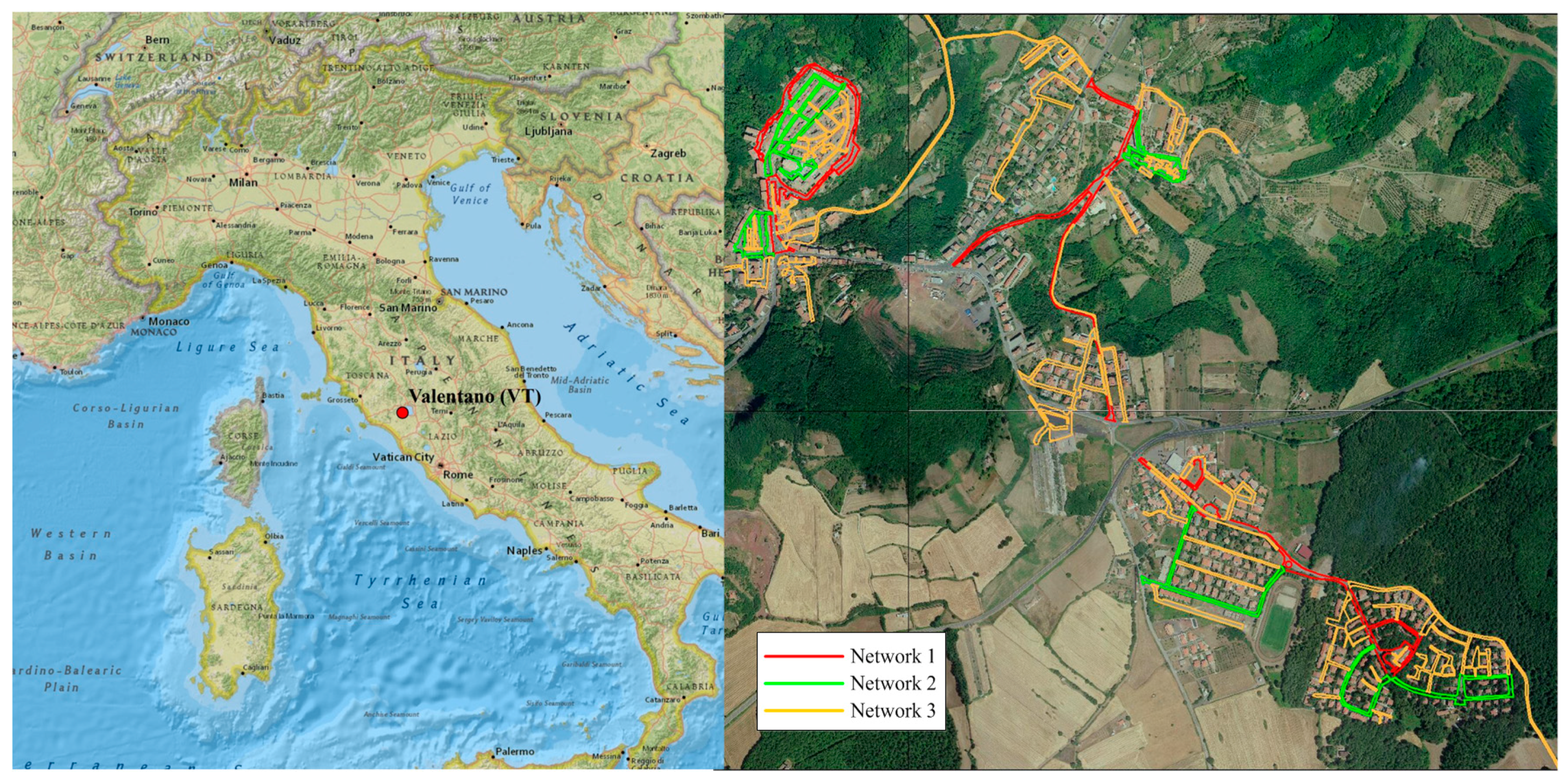
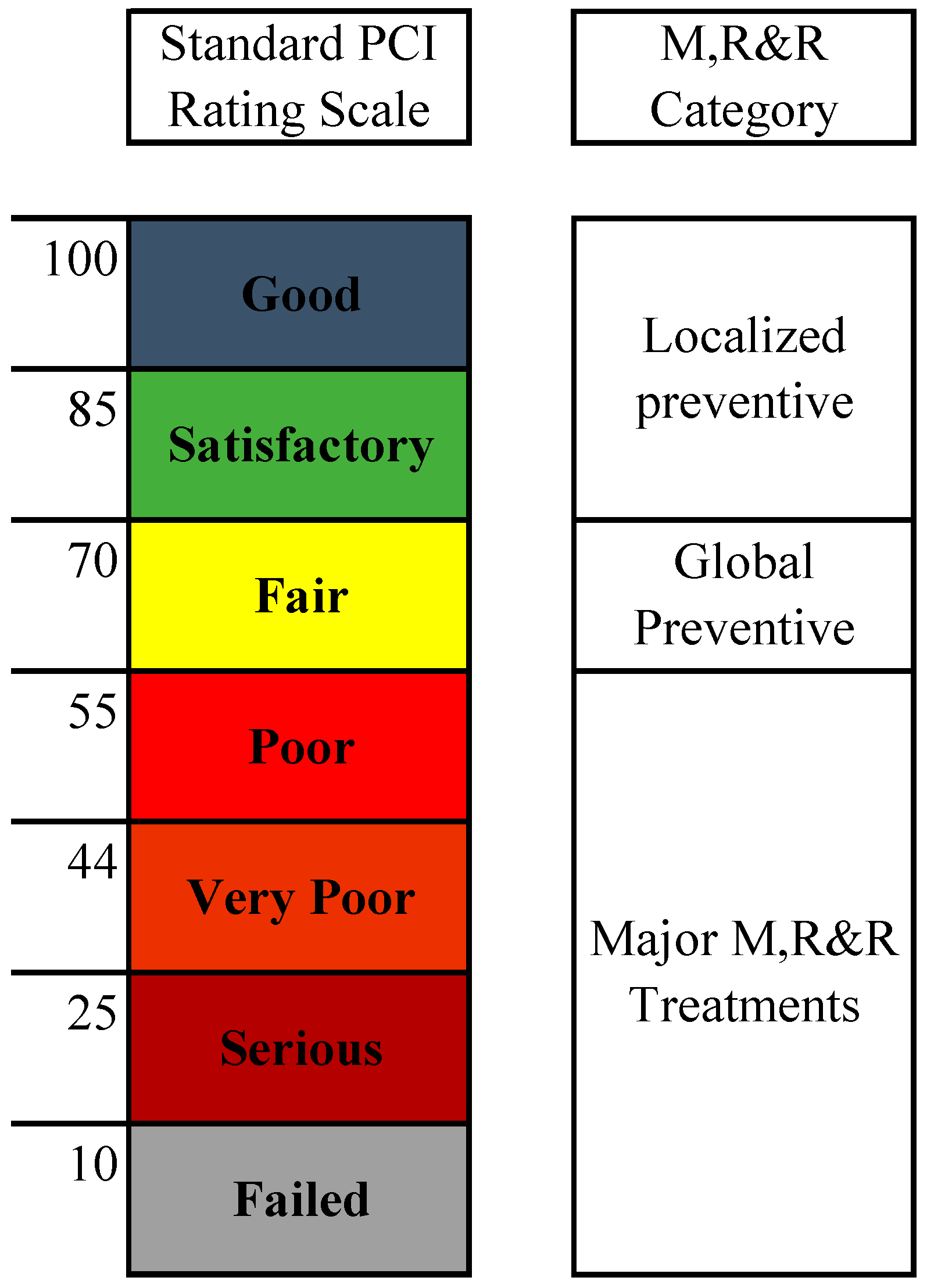
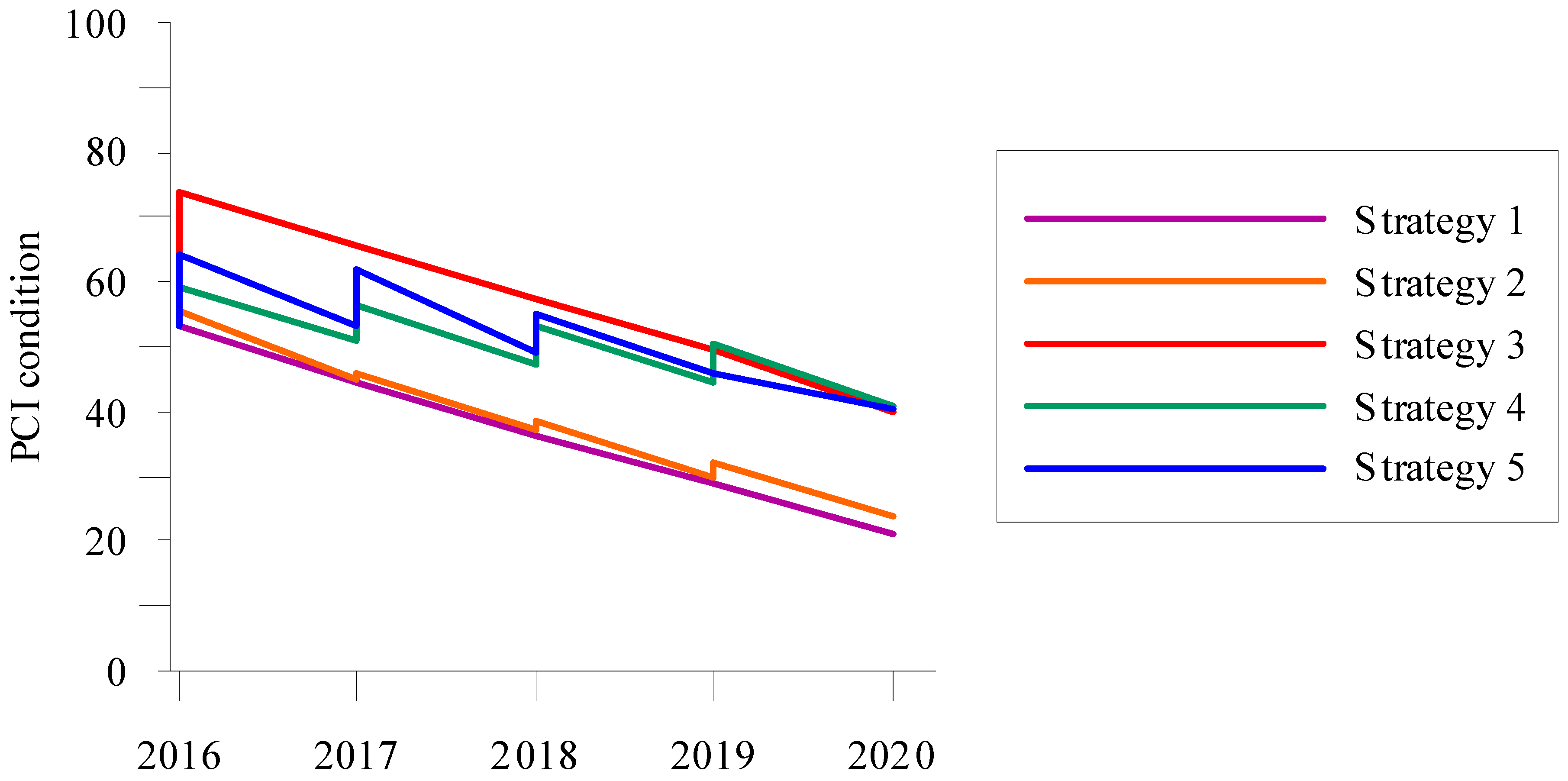
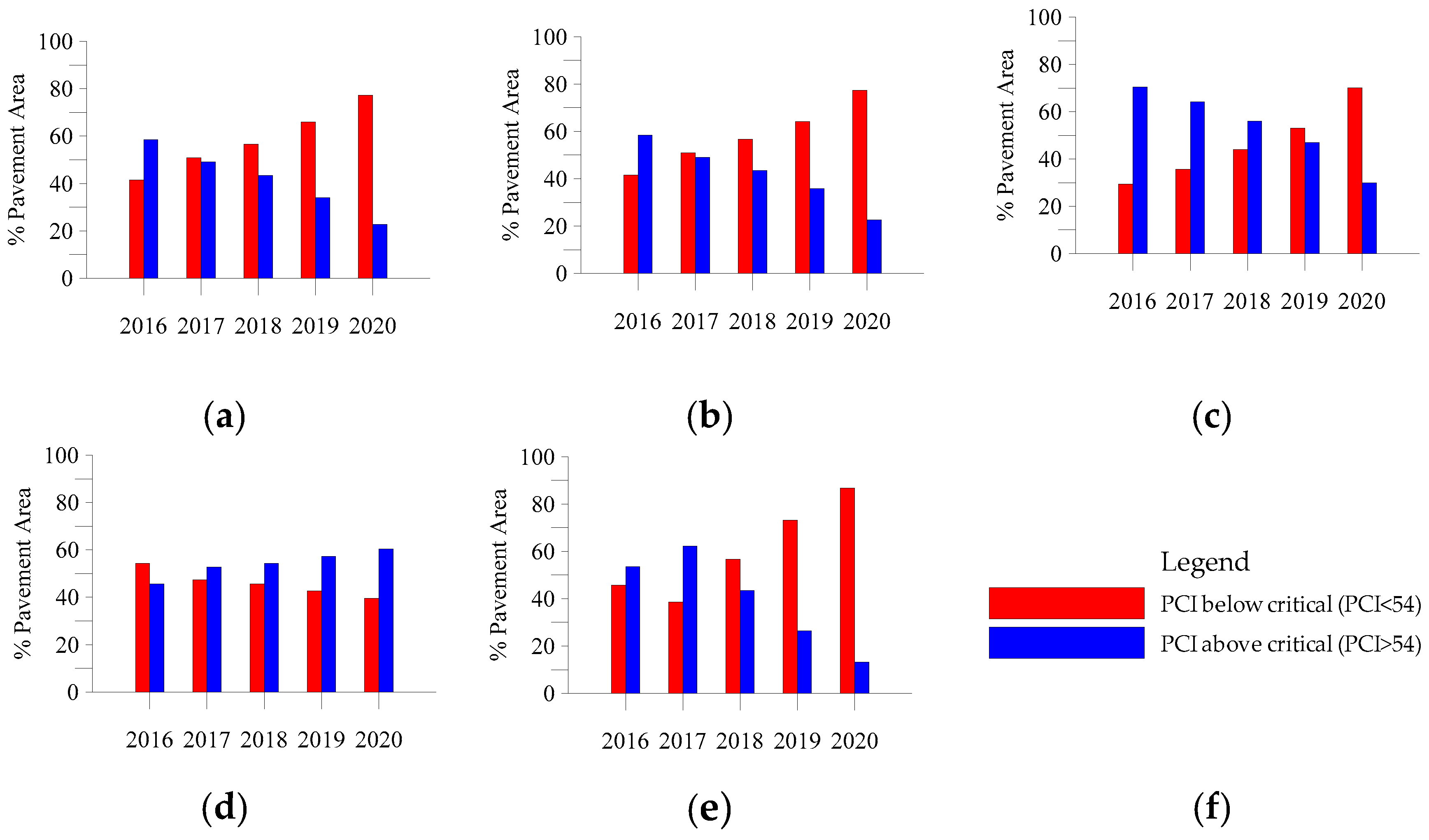

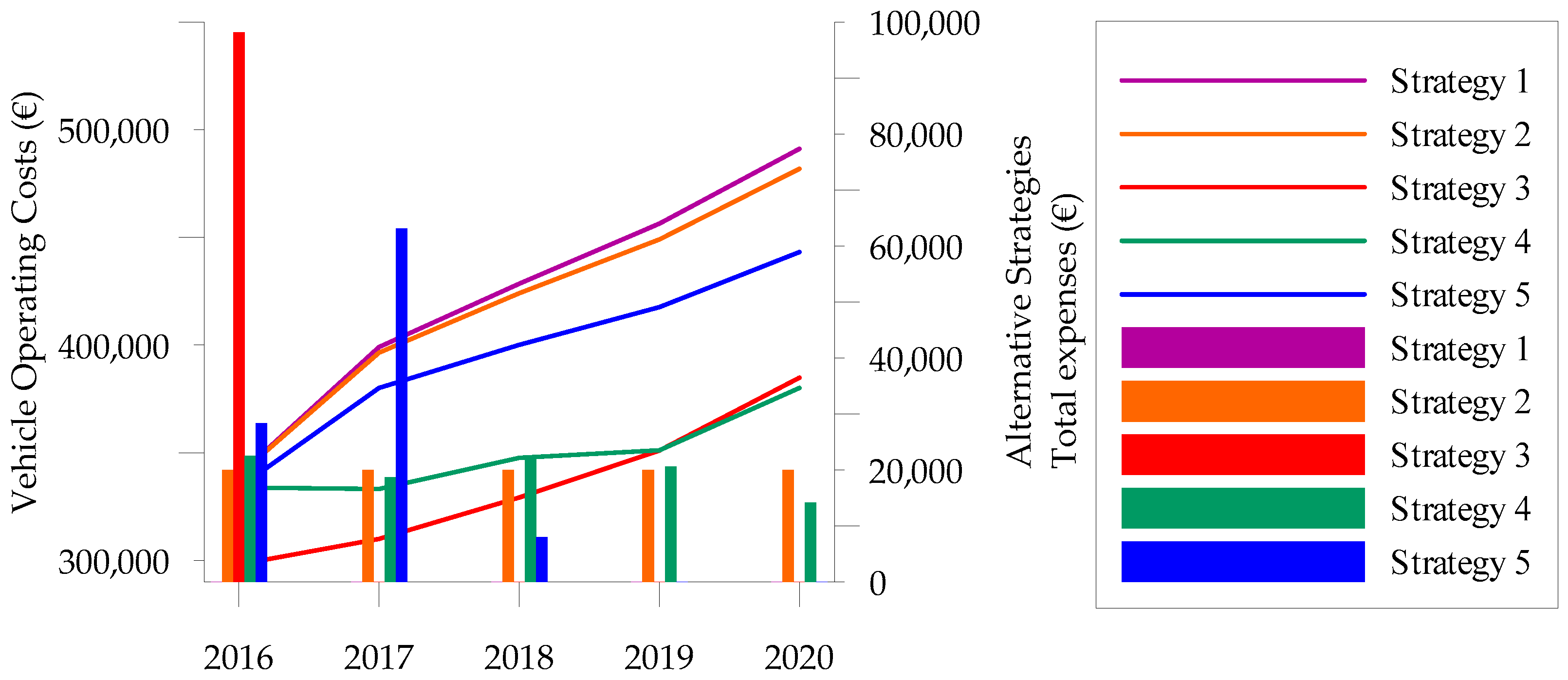
| Treatment Description (Code) | Unit Cost | |
|---|---|---|
| Minor M, R & R treatment | No Localized M&R (NONE) | - |
| Crack-Sealing (CR-SEAL) | 2.31 (€/m) | |
| Slurry-Seal (SR-SL) | 4.06 (€/m2) | |
| Manhole-Reconstruction (RC_MH) | 82.99 (€/piece) | |
| Grinding-Localized (GR-LOC) | 4.38 (€/m2) | |
| Patching-Leveling (PAT-LV) | 11.06 (€/m2) | |
| Patching-Deep (PAT-DP) | 22.12 (€/m2) | |
| Major M, R &R treatment | Overlay-Thin-AC (OL-AC) | 10.62 (€/m2) |
| Surface-Reconstruction (SR-RC) | 21.85(€/m2) | |
| Complete-Reconstruction (CPL-RC) | 37.77 (€/m2) | |
| Strategy | Branch Id. | Section No. | Year | Section Area | PCI before | M, R&R treatments costs (€) |
|---|---|---|---|---|---|---|
| Strategy 3 | B1 | S1 | 2016 | 175 | 24 | 1858.50 |
| B3 | S2 | 2016 | 431 | 29 | 4577.22 | |
| B4 | S2 | 2016 | 810 | 35 | 8602.20 | |
| B4 | S6 | 2016 | 233 | 6 | 2474.46 | |
| B4 | S7 | 2016 | 241 | 69 | 2559.42 | |
| B5 | S2 | 2016 | 2127 | 8 | 22,588.74 | |
| B5 | S3 | 2016 | 512 | 19 | 5437.44 | |
| B5 | S5 | 2016 | 410 | 28 | 4354.20 | |
| B5 | S7 | 2016 | 438 | 15 | 4651.56 | |
| B6 | S8 | 2016 | 1021 | 14 | 10,843.02 | |
| B9 | S4 | 2016 | 647 | 31 | 6871.14 | |
| B10 | S4 | 2016 | 428 | 65 | 4545.36 | |
| B10 | S5 | 2016 | 438 | 27 | 4651.56 | |
| B10 | S6 | 2016 | 233 | 58 | 2474.46 | |
| B11 | S2 | 2016 | 1,097 | 62 | 11,650.14 | |
| Strategy 4 | B5 | S2 | 2016 | 2127 | 8 | 22,588.74 |
| B4 | S6 | 2017 | 233 | 6 | 2474.46 | |
| B5 | S3 | 2017 | 512 | 19 | 5437.44 | |
| B6 | S8 | 2017 | 1021 | 14 | 10,843.02 | |
| B1 | S1 | 2018 | 175 | 24 | 1858.50 | |
| B3 | S2 | 2018 | 431 | 29 | 4577.22 | |
| B4 | S2 | 2018 | 810 | 35 | 8602.20 | |
| B9 | S4 | 2018 | 647 | 31 | 6871.14 | |
| B5 | S5 | 2019 | 410 | 28 | 4354.20 | |
| B5 | S7 | 2019 | 438 | 15 | 4651.56 | |
| B10 | S4 | 2019 | 428 | 65 | 4545.36 | |
| B10 | S5 | 2019 | 438 | 27 | 4651.56 | |
| B10 | S6 | 2019 | 233 | 58 | 2474.46 | |
| B4 | S7 | 2020 | 241 | 69 | 2559.42 | |
| B11 | S2 | 2020 | 1097 | 62 | 11,650.14 | |
| Strategy 5 | B2 | S1 | 2016 | 952 | 71 | 9919.84 |
| B4 | S2 | 2016 | 809 | 35 | 8429.78 | |
| B11 | S2 | 2016 | 733 | 77 | 7637.86 | |
| B4 | S6 | 2016 | 236 | 6 | 2430.80 | |
| B1 | S1 | 2017 | 175 | 18 | 1823.50 | |
| B11 | S1 | 2017 | 733 | 72 | 12,993.74 | |
| B4 | S1 | 2017 | 2009 | 38 | 20,933.78 | |
| B4 | S4 | 2017 | 1894 | 62 | 19,735.48 | |
| B3 | S1 | 2017 | 1247 | 71 | 7637.86 | |
| B8 | S1 | 2018 | 321 | 61 | 3344.82 | |
| B7 | S1 | 2018 | 448 | 61 | 4668.16 |
| Branch Id. | Section No. | Passenger Cars | Van | Bus |
|---|---|---|---|---|
| B1 | S1 | 800 | 10 | 0 |
| B1 | S2 | 800 | 10 | 0 |
| B2 | S1 | 800 | 20 | 0 |
| B3 | S1 | 1000 | 30 | 0 |
| B3 | S2 | 1000 | 30 | 0 |
| B4 | S1 | 800 | 20 | 20 |
| B4 | S2 | 800 | 20 | 20 |
| B4 | S4 | 1300 | 30 | 20 |
| B4 | S6 | 1300 | 30 | 20 |
| B4 | S7 | 1300 | 30 | 20 |
| B5 | S1 | 3000 | 70 | 50 |
| B5 | S2 | 3000 | 70 | 50 |
| B5 | S3 | 2000 | 40 | 1 |
| B5 | S4 | 2000 | 40 | 1 |
| B5 | S5 | 2000 | 40 | 1 |
| B5 | S6 | 2000 | 40 | 1 |
| B5 | S7 | 2000 | 40 | 1 |
| B6 | S1 | 2000 | 40 | 0 |
| B6 | S7 | 2000 | 40 | 0 |
| B6 | S8 | 2000 | 40 | 0 |
| B6 | S9 | 2000 | 40 | 0 |
| B7 | S1 | 800 | 10 | 0 |
| B8 | S1 | 150 | 10 | 0 |
| B9 | S1 | 3700 | 100 | 0 |
| B9 | S3 | 3700 | 100 | 0 |
| B9 | S4 | 3700 | 100 | 80 |
| B10 | S4 | 1000 | 30 | 50 |
| B10 | S5 | 1000 | 30 | 50 |
| B10 | S6 | 1000 | 30 | 50 |
| B10 | S3 | 1000 | 30 | 0 |
| B11 | S1 | 500 | 10 | 0 |
| B11 | S2 | 500 | 10 | 0 |
| Strategy | VOC Total [€] | VOC Reduction [€] | Medium PCI before | Medium PCI after | No. Sections below Critical PCI after |
|---|---|---|---|---|---|
| Strategy 1 | 2,114,987 | 0 | 53 | 21 | 41 |
| Strategy 2 | 2,091,395 | 23,593 | 53 | 23 | 41 |
| Strategy 3 | 1,673,448 | 441,539 | 53 | 40 | 37 |
| Strategy 4 | 1,746,079 | 368,909 | 53 | 40 | 32 |
| Strategy 5 | 1,975,060 | 139,927 | 53 | 40 | 46 |
© 2017 by the authors. Licensee MDPI, Basel, Switzerland. This article is an open access article distributed under the terms and conditions of the Creative Commons Attribution (CC BY) license ( http://creativecommons.org/licenses/by/4.0/).
Share and Cite
Loprencipe, G.; Pantuso, A.; Di Mascio, P. Sustainable Pavement Management System in Urban Areas Considering the Vehicle Operating Costs. Sustainability 2017, 9, 453. https://doi.org/10.3390/su9030453
Loprencipe G, Pantuso A, Di Mascio P. Sustainable Pavement Management System in Urban Areas Considering the Vehicle Operating Costs. Sustainability. 2017; 9(3):453. https://doi.org/10.3390/su9030453
Chicago/Turabian StyleLoprencipe, Giuseppe, Antonio Pantuso, and Paola Di Mascio. 2017. "Sustainable Pavement Management System in Urban Areas Considering the Vehicle Operating Costs" Sustainability 9, no. 3: 453. https://doi.org/10.3390/su9030453








